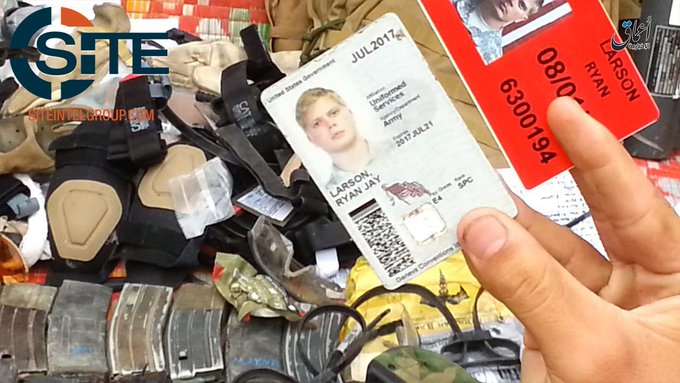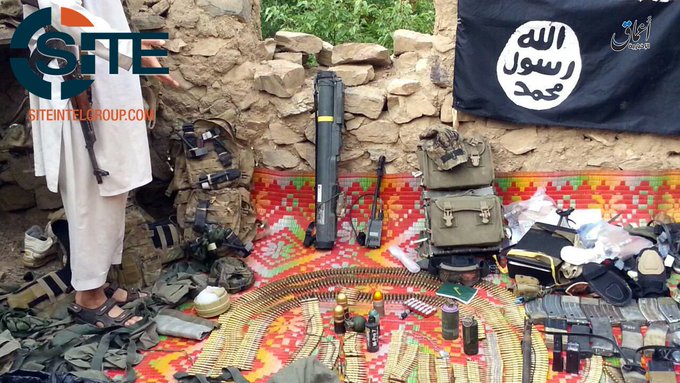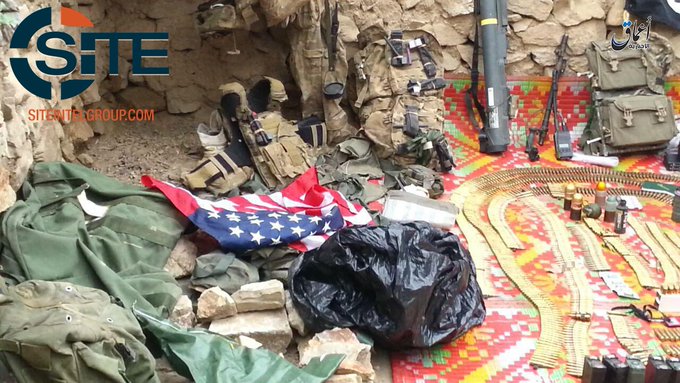August 6, 2016
 The Islamic State group is circulating photos of potentially sensitive American military equipment and identification cards purportedly confiscated by militants after recent battlefield engagements in Afghanistan.
The Islamic State group is circulating photos of potentially sensitive American military equipment and identification cards purportedly confiscated by militants after recent battlefield engagements in Afghanistan.
The photos show a variety of weapons, ammunition, communications gear and accessories. Perhaps the most chilling image is a closeup of someone holding two ID cards belonging to a U.S. soldier, Spc. Ryan Jay Larson.
#ISIS 'Amaq posted photos of documents and gear of#American soldiers allegedly taken by ISIS fighters in#Nangarhar
It's unclear when the photographs were taken and what precisely transpired, although there are no reports of any American military personnel having been captured, said Henrietta Levin, a Defense Department spokeswoman.
"We are aware of erroneous reports that U.S. Army Specialist Ryan Jay Larson was captured by ISIL in Afghanistan," Levin said, referring to one the Islamic State group's other monikers. "These reports are false. He has been accounted for and remains in a duty status within his unit. We are looking into how he lost possession of his ID but can confirm he has been accounted for with his unit."
Levin provided no additional details about the photographs and declined to address several questions submitted by Military Times.
A White House official referred questions to the Defense Department.
The images were shared on social media Saturday by the SITE Intelligence Group, which monitors ISIS and other terrorist organizations. SITE indicated that the photos were originally published by the Islamic State group's Amaq news agency after ISIS fighters confiscated the equipment and documents in Afghanistan's Nangarhar province.
American special operations troops are operating in Nangarhar province, which borders Pakistan. The region has become a stronghold for the estimated 1,000 to 1,500 ISIS militants in Afghanistan. Most are believed to be disaffected Taliban who were forced out of Pakistan.
In late July, five American troops were wounded there during separate engagements with ISIS fighters, the top U.S. commander in Afghanistan, Army Gen. John Nicholson, said recently. The Americans were accompanying a group of Afghan troops on what Nicholson described as a clearing mission intended to help the Afghans reclaim territory lost to ISIS. None of the injuries was life threatening, Nicholson said.
It's not immediately clear how ISIS came into possession of equipment that was photographed. But it's fairly substantial, said Fred Galvin, a retired Marine Corps officer who led a special operations unit in Nangarhar province in 2007.
Among the items is a M72 single-shot rocket launcher and a spare barrel for an M240 machine gun. There are 40mm grenades, a hand grenade and smoke grenades, and numerous 5.56mm rifle rounds and bigger 7.62mm rounds, which are fired from M240s and sniper rifles.
There's a ruck sack, some body armor, knee pads, eye goggles, gauze, tourniquets and other medical supplies, a multiband radio and flex cuffs used to detain bad guys. Some of the gear appears to be standard issue, Galvin said, while other items are used only by "more advanced" military units.
An American flag appears in one of the images.
"From the looks of all of this," Galvin said, "it appears [the perpetrators] may have hit a fixed position. Maybe they ran across an observation post, or a site where guys were sleeping, bedding down. You can't tell 100 percent. But it does look like someone was caught in a hasty attack. If they knew they were going to be attacked like that, they would have been wearing their body armor."
The volume and variety of items could suggest the Americans were forced to leave it behind — quite possibly in a hurry.
The radio is most concerning, said Shawn Snow, a Marine Corps veteran who served as a signals intelligence analyst during multiple tours to Afghanistan and Iraq. It's a PRC-148, also known as the Multiband Inter/Intra Team Radio, or MBITR.
"It's one of the most commonly used portable radio systems employed by coalition and NATO forces. If ISIS has captured several of these radios, it would provide them with deadly capabilities," Snow said, noting the device was developed by U.S. Special Operations Command during the 1990s. "Usually, the Taliban communicates on a simple push-to-talk walkie talkie. These radios are very easy for coalition forces to intercept, providing timely indications and warnings of pending attacks. If ISIS has several of these MBITR radios, it could provide them with the ability to escape detection and interception through its programmable cryptologic function and frequency hopping abilities.
"Even a small command and control node could do considerable damage being able to operate undetected with little to no warning. It would also provide them with extended range over their small hand held Chinese made radios."
ISIS is hoping to capitalize on this propaganda, Galvin surmised. He cautioned, however, that until there's confirmation from the Pentagon, it's impossible to know for sure whether this is a legit score for the enemy.
"Americans have been in Nangarhar for years," he added. "All of that equipment could have been bought in a local bazar. It's possible this is just a deception operation. 'Hey look. We attacked them. We destroyed them.' It could be a complete ruse."




No comments:
Post a Comment